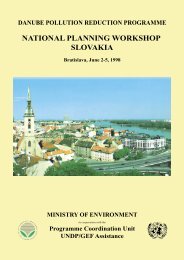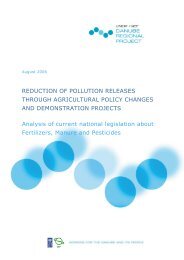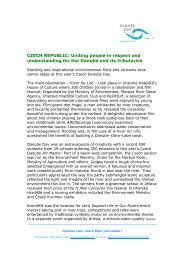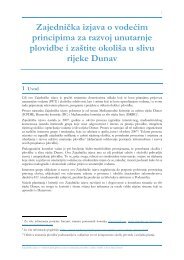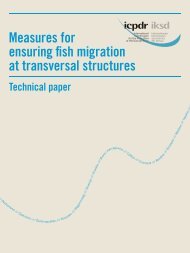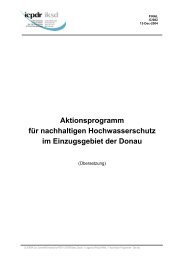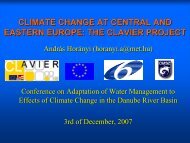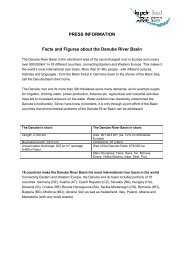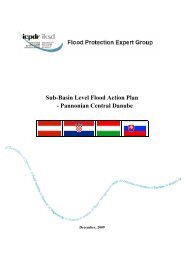Technical Reports Parts C,D - ICPDR
Technical Reports Parts C,D - ICPDR
Technical Reports Parts C,D - ICPDR
You also want an ePaper? Increase the reach of your titles
YUMPU automatically turns print PDFs into web optimized ePapers that Google loves.
<strong>Technical</strong> <strong>Reports</strong> – Part D: Water Environmental Engineering 139<br />
and finalized the State Committee for Water Management submits the corresponding informations<br />
to the Ministry for Statistics of Ukraine in the form of quantified pollution performance for towns,<br />
regions etc.<br />
The Ukrainian Ministry for Agricultural Produce operates monitoring units that measure the<br />
content of pesticide and nitric combinations in surface water.<br />
The Ministry for Environmental Protection and Nuclear Safety of Ukraine is not able to ensure<br />
regular monitoring of the quality of water in the Danube basin and uses mainly the informations<br />
provided by the State Committee for Hydrometeorology and by Ministry of Health Protection of<br />
Ukraine. Local representatives of the Ministry for Environmental Protection and Nuclear Safety of<br />
Ukraine perform only random effluent sampling to check out the compliance with environmental<br />
regulations. Such verification envisages sampling 500 meters downstream the point, where<br />
effluents are released. It enables to determine “possible dissolution” of effluents, which is<br />
necessary to calculate content limitations. The inspection departments to the Ministry for<br />
Environmental Protection and Nuclear Safety of Ukraine perform analyses of water samples<br />
downstream releasing points to identify eventual infractions and to apply civil penalties.<br />
The other agencies responsible for conducting the state water monitoring include the State<br />
Committee on Geology and Mineral Resources (SCGMR), the State Committee for Housing and<br />
Communal Services (SCHCS), their local authorities, as well as organizations that pertain to the<br />
regulative sphere of the above mentioned ministries and state agencies.<br />
The National Space Agency of Ukraine (NSAU) provides the agencies conducting the state water<br />
monitoring with the available historical and up-to-date aero-cosmic information from the remote<br />
gauging of the territory of Ukraine.<br />
The state water monitoring is conducted with the aim of ensuring collection, processing, storage,<br />
and analysis of the information on the condition of waters, prediction of its changes, and<br />
development of the recommendations for making scientifically substantiated decisions in the field<br />
of water usage and protection, and water resources restoration.<br />
The state water monitoring is conducted in terms of water quantity and quality.<br />
Subjects of the state water monitoring are as follows:<br />
<br />
<br />
<br />
<br />
<br />
<br />
<br />
surface waters;<br />
natural water bodies (lakes), water courses (rivers, streams);<br />
artificial water bodies (reservoirs, ponds), channels and other water bodies;<br />
groundwater and springs;<br />
internal sea waters and territorial sea; exclusive Ukrainian (marine) economic zone;<br />
sources of water pollution, including wastewater; accidental discharges of liquid products<br />
and wastes; products and material losses in a process of mineral resources extraction<br />
within aquifers of surface waters, internal sea waters, territorial sea waters and exclusive<br />
Ukrainian (marine) economic zone; as well as dumping of wastes, waters of surface<br />
drainage from the agricultural fields, filtration of pollutants from technological water<br />
bodies and reservoirs; and massive growth of the blue-and-green algae;<br />
release of harmful substances from sediments (secondary pollution), and other sources of<br />
pollution, which could be subject to observation.<br />
The following water objects in Ukrainian surface should be monitored:<br />
<br />
<br />
<br />
water bodies, which are recipients for wastewater from large towns<br />
wastewater discharges from separate industrial facilities<br />
water area used for fishing



